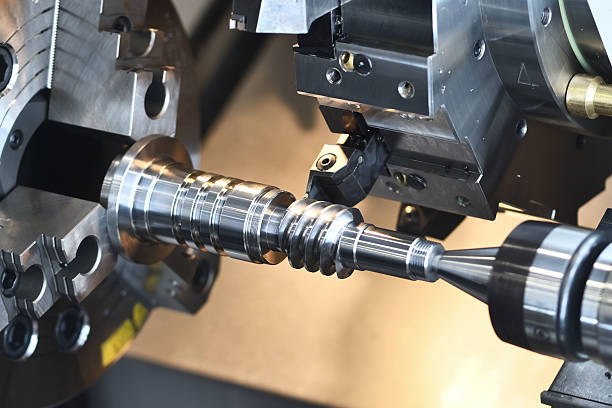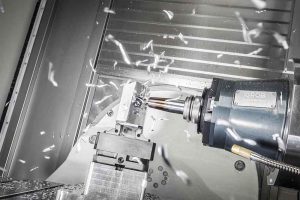High-speed steel for versatility, carbide for tough materials, ceramic for heat resistance, diamond for superior finishes, and specialized tools for unique tasks
High-Speed Steel Tools
High-Speed Steel tools are a staple of CNC machining in general, offering a mixture of toughness and high-temperature softening resistance. This type of steel normally consists of carbon steel alloyed with such elements as tungsten, molybdenum, chromium, and vanadium that give the final product its needed hardness under the intense conditions of cutting. At the same time, HSS is not as hard as carbide, which is beneficial in many scenarios.
Composition and Characteristics
One of the high-speed steel’s main characteristics is its considerable resistance to wear and ability to stay “hard” at temperatures not exceeding 600°C. This makes it an excellent material for operations that do not involve cutting temperatures high or low enough to make carbide or ceramics more advisable to work with. HSS also has a certain hardness that can range from 64 to 66 on the Rockwell scale in its normal form, which is very close to the typical values of 65 – carburetors are of 85. Carbide values of around 85 effectively exclude the material from the list of usable options for cutting softer metals such as aluminum or mild steel or any medium used in woodworking.
Manufacturing and Treatment
The process of creating high-speed steel includes alloying it with the listed elements, followed by annealing and quenching. Finally, the tools are typically heat treated through tempering, which reduces the brittleness while keeping the overall hardness. As a result, HSS is hard while still being somewhat ductile.
Usage in CNC and Other Aspects
HSS is mostly used in CNC machining for drill bits, taps, and finally, end mills under conditions that do not consistently favor carbide in terms of their economic value or pure performance. The CNC machines that deal with softer plastics and metals can use HSS as a cheaper alternative that does not wear out as quickly as carbide – the resistance of wood to this type of wear is considerable as well. The industry generally prefers HSS for scenarios requiring a high degree of tool flexibility, such as complex shapes and fine detailing. The biggest advantage of this material is its lack of chipping and breaking under conditions where a harder tool might be more likely to fail, such as less secure machining set-ups or with older non-ferrous metals.

Carbide Blades
Carbide blades are among the principal types of CNC cutting tools due primarily to their extreme toughness and longevity in an industrial machining environment. These blades are constructed with a combination of carbide particles and a metal matrix, usually tungsten carbide that has been bonded with cobalt. Carbide blades can have a measured hardness that rises to 90 on the Rockwell scale, making them prime candidates for cutting hard materials such as hardened steels, cast iron, and non-ferrous metals. They exhibit several exceptional mechanical and metallurgical characteristics making a carbide blade a distinctive tool.
Material Composition and Properties
Typically, carbide blades are produced with a major component of 70-97% tungsten carbide, with the remaining component being the metallic cobalt. The cobalt acts as the binder that holds the material, giving it a measure of the toughness, which makes it not too brittle. The performance of the blade can be influenced by the amount of cobalt, with lower cobalt content increasing the effectiveness of the blade’s performance and high cobalt content increasing its toughness. Producing carbides into blades is a difficult process due to the problems with support strength and surface quality. Blade properties are influenced particularly by the carbide particle size and spatial distribution. These particles should be fine and controlled in a random spatial distribution.
Manufacturing
The production process for carbide blades is a form of powder metallurgy. It can be divided up into several steps. First, the tungsten carbide and the cobalt particles are finely ground, then are mixed together while being closely controlled. The mixture is then pressurized into the required shape and is then sintered in an oven at high temperatures. This forms the carbide particles into a solid mass. This sintering process is crucial as it determines the uniformity and strength of the final product.
Applications and Cutting Performance
Carbide blades are notable for their ability to maintain a sharp cutting edge in high temperatures, which are a common byproduct of high-speed machining. They are highly effective in precision applications that require wear resistance. For example, in the aerospace and automobile industries, where materials such as titanium alloys and hardened stainless steel are prevalent, they have become indispensable. They may slash machining time in the production of an identical aerospace component by as much as half. Primarily, less stiff materials cannot be run at the required speeds. Another benefit to this is the fact that cutting speeds can also be increased, leading to higher productivity and cost savings. They also have a significantly longer life than high-speed steel blades, in the range of ten to twenty times the life in comparable applications at a similar cost.
Ceramic Tools
Ceramic tools are a critical segment in modern CNC machining, providing unique benefits due to their composition and material properties. These tools are made from inorganic materials such as alumina (Al2O3) and silicon nitride (Si3N4), which offer exceptional hardness and heat resistance.
Material Composition and Mechanical Properties
Ceramic tools are primarily made from fine ceramic powders that are sintered at high temperatures to achieve a dense and hard material. The resulting tools exhibit hardness levels that can exceed those of carbide tools, often reaching up to 93 on the Rockwell scale. This extreme hardness allows them to maintain sharp edges even under high temperatures, typically up to 1000°C, which is significantly higher than the threshold for most carbide and high-speed steel tools.
Production Process
The production of ceramic tools involves precise control over material properties through advanced sintering techniques. These techniques include pressureless sintering, hot pressing, and even newer methods like spark plasma sintering which reduce porosity and increase the uniformity of the ceramic. The fine-grained structure obtained through these processes is essential for achieving the high strength and durability required for cutting hard materials.
Applications in High-Speed Machining
Ceramic tools are particularly advantageous for high-speed machining of hard metals such as nickel-based alloys and hardened steels, commonly used in aerospace and automotive industries. Their ability to withstand high temperatures reduces tool wear and failure rates, enabling faster machining speeds and hence, higher productivity. For instance, in turning operations of Inconel 718, a tough superalloy, ceramic tools can operate at cutting speeds approximately 4 to 6 times greater than those achievable with carbide tools.
Advantages and Performance Metrics
The key advantage of ceramic tools lies in their thermal properties. The low thermal conductivity of ceramics ensures that the heat generated during machining is concentrated in the chip and away from the tool and workpiece. This characteristic minimizes thermal damage to the part being machined and enhances the overall surface finish. Moreover, the wear resistance of ceramics often translates into longer tool life and reduced downtime for tool changes, making them cost-effective for specific high-wear applications.
Diamond Coated Tools
At the top of CNC cutting technology are diamond coated tools, which are characterized by extreme hardness and wear resistance. These kinds of tools are almost always made from a rigid substrate such as tungsten carbide, and onto it, a thin coating of diamond particles is laid. This coating is usually made either through chemical vapor deposition or physical vapor deposition.
Composition and Coating Techniques
Diamond coated tools are made possible by the extreme hardness of diamond, the hardest known material, which ranks at 10 on the Mohs scale and around 8000 on the Vickers hardness scale. This process involves depositing diamond particles that are too small to see with the naked eye on the tungsten carbide substrate. One of the most prevalent methods is the CVD method in which a gas mixture of hydrocarbons and hydrogen is let into a chamber that has been arrested of air. The gases are then heated to the point of dissociation and deposit themselves as diamond to coat the end of the tool.
Machining Applications
The major advantage of diamond coated tools is that they can serve years of use without wearing out on any workpiece. This is particularly useful as some of the workpieces like graphite, composites, green ceramics, and high-silicon aluminum alloys are abrasive and wear out other types of tools instantly. For example, when machining carbon fiber-reinforced plastics CFRP, diamond coated tools can cut up to fifty times the life of an uncoated tool. The fact that they stay in form further increases their popularity by cutting the total tooling cost even where the ex-works costs are higher considering the life cycle of a product.
Operational Efficiency
These long life of service also increases the efficiency of any operation where these tools are used. For example, when machining automotive aluminum components, diamond coated tools can increase tool change intervals and reduce machine idle time. The result of this is that the automotive component production cycle is maintained, and the cost of machining is reduced.

Specialty Tools
In CNC machining, specialty tools are created and designed to complete a specific task or task’s which standard CNC tools are not able to perform. Those tools are particularly developed to satisfy special requirements of specific industries, and thus, cannot be widely used in different areas. This group of specialty tools includes engraving and threading tools, form tools and custom cutter tools which are designed mainly in familiar tasks, such as cutting, milling, and drilling.
Engraving Tools
Engravement is used for work on various materials: metals, plastics, composite wood. Sharps reshaped because of forceful impact form top, deep, accurate obtuse-angled cuttings. Except standard engravement, there dentate tool, perforating tool. Engraving tool consists of a holder and of a standard exchangeable tip with a diamond at its end. Engraving tools with tip diameter up to 0.1mm are used for highly precise detailed engravement to make images, quality sealings, jewellery such as chainlets and multiples, sides of semi-shares, electronic microchips.
Threading Tools
Threading tools are used to make spiral grooves in the internal part of hole for making jaws and in the external part of detail; for instance outer of bolts, screws and nuts, and cylinder’s surface. Nuts’, bolt’s, and screw’s outside are shaped by screw tap. Except screw taps there are also screw dies for making of an inner of holes up to 6mm M.
Form Tools
They make detail’s shape during one passage. Weiner tool is an individual special tool made from qualities of tool steel barm with reamers of high speed steels, and from carbide of tungsten, cobalt, and tantalum.
Custom Cutter Tools
These tools are created to facilitate the work and make different unfortunate work of the product. Because of geometric specifics of custom tools, geometry of sharps is widened and work without a demand for applications and special equipment is conducted. These tools can be as standard diameter as a custom one. These tools are usually made for a particular case, for example, for a prototype or for specific elastic sizes. Advantages custom cutters are that they rely on “the user to determine the exact tool geometry for exact workpiece or materials and/or workflow solutions with long lead time”. Custom cutters have kept developing and are now produced with bimetal with the possibility to have different helix angles and are coated with multiple arrangements to add wear resistance for tool’s life.collectionView similar used By: from_answer.









